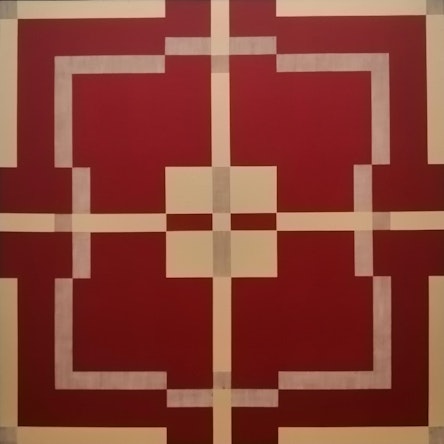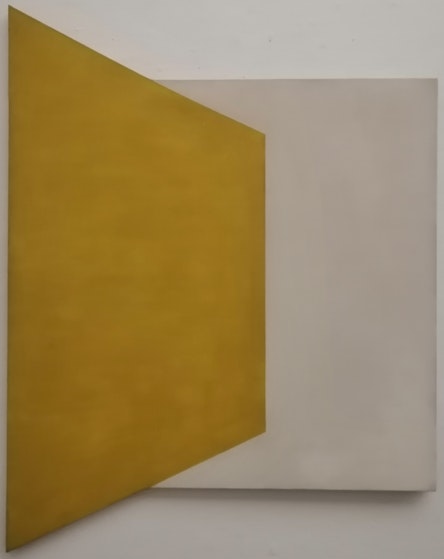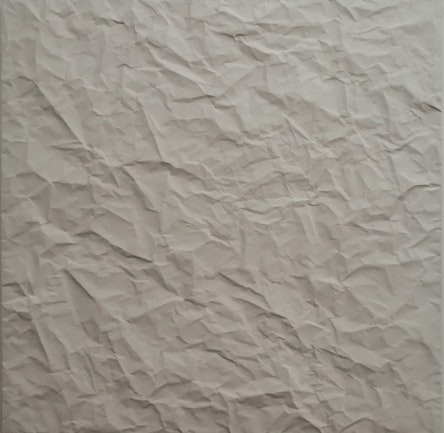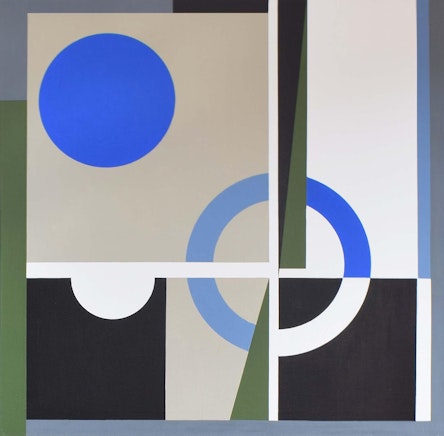
Alonso Garcés Galería is pleased to propose for our next participation in ArtBo, the works of three artists of the same generation with an extensive and prolific career; a consistent, serious and persevering production, which allows them to be considered today consecrated figures of Latin American geometric abstraction. Our proposal includes an important number of works from different periods of their respective works and represent, in our opinion, a harmonious, austere and homogeneous unity, unquestionably marked by an extreme rigor of "purification" of line, form and color, three related languages that, in a constant symbolic dialogue tinged with a large dose of mysticism, will take the viewer to the sublime "thresholds" of abstraction. Manolo Vellojín, always distant from the style "fashions" imposed by the "passing of time", left us a singular, unique work, impregnated with that extreme rigor that, as an essence, is the vehicle of his unwavering search for perfection. Pedro Tagliafico and Jorge Riveros, continue in an active and dynamic production that keeps surprising us. Reaffirming its validity. A constant exploration that is renewed from a rational and orderly analysis, resulting in an innovative work, new and very much in line with our time.
Since its foundation in 1977, the Gallery Garcés Velázquez, today ALONSO GARCÉS GALLERY, has set a standard of excellence in the dissemination and promotion of national and international plastic arts, always maintaining as a primary objective the prospecting and discovery of young talents, the accompaniment and support of recognized artists. Painting, sculpture, videos and all kinds of art expressions have passed through its facilities. In its store, in addition to works related to the character of the space, you will find books and various objects.

Manolo Vellojín Manolo Vellojín's work has always been distinguished by its perfectionism and delicacy. All his work displays a scrupulous precision as well as a fineness and neatness that collaborate in his ambitious attempt to represent the unrepresentable, to concretize the inscrutable by confronting it in a rational way. For Vellojín, art was above all a way to evoke the spiritual dimension of the human being and for this reason his works incite introspection, to reflect on life and death, to reconcile interiority and exteriority, provoking the concentration of the observer in the few but strongly symbolic elements that compose them. Among his most exquisite productions are his Ascensiones, especially refined works in which Vellojín abandoned the two-dimensionality of most of his works, but not with the intention of producing sculptures since they are works arranged to be appreciated frontally, but with the intention of insinuating lightness, elevation and transmitting sublimity, that is, to infect us with that impulse of understanding the infinite that was one of the main reasons for his art, although for this, we have to rely on the finite powers of our reason. Eduardo Serrano - 2012

Manolo Vellojín Manolo Vellojín's work has always been distinguished by its perfectionism and delicacy. All his work displays a scrupulous precision as well as a fineness and neatness that collaborate in his ambitious attempt to represent the unrepresentable, to concretize the inscrutable by confronting it in a rational way. For Vellojín, art was above all a way to evoke the spiritual dimension of the human being and for this reason his works incite introspection, to reflect on life and death, to reconcile interiority and exteriority, provoking the concentration of the observer in the few but strongly symbolic elements that compose them. Among his most exquisite productions are his Ascensiones, especially refined works in which Vellojín abandoned the two-dimensionality of most of his works, but not with the intention of producing sculptures since they are works arranged to be appreciated frontally, but with the intention of insinuating lightness, elevation and transmitting sublimity, that is, to infect us with that impulse of understanding the infinite that was one of the main reasons for his art, although for this, we have to rely on the finite powers of our reason. Eduardo Serrano - 2012

Manolo Vellojín Manolo Vellojín's work has always been distinguished by its perfectionism and delicacy. All his work displays a scrupulous precision as well as a fineness and neatness that collaborate in his ambitious attempt to represent the unrepresentable, to concretize the inscrutable by confronting it in a rational way. For Vellojín, art was above all a way to evoke the spiritual dimension of the human being and for this reason his works incite introspection, to reflect on life and death, to reconcile interiority and exteriority, provoking the concentration of the observer in the few but strongly symbolic elements that compose them. Among his most exquisite productions are his Ascensiones, especially refined works in which Vellojín abandoned the two-dimensionality of most of his works, but not with the intention of producing sculptures since they are works arranged to be appreciated frontally, but with the intention of insinuating lightness, elevation and transmitting sublimity, that is, to infect us with that impulse of understanding the infinite that was one of the main reasons for his art, although for this, we have to rely on the finite powers of our reason. Eduardo Serrano - 2012

Pedro Tagliafico The exhibited works comprise the last decades of the artist's active and prolific production, which, like his previous works, are born from a strict rational analysis and concept. At the beginning of the 1960s Pedro Tagliafico settled in London, thus beginning his long stay in Europe, as opposed to other Latin American artists of his generation who directed their production to the "dogmas" outlined by kinetic art. Tagliafico's search and interest was directed to other currents, and it was in Italy, the country where he lived from 1970 onwards, that he indisputably changed the course of his work. At that time, Italy was far from being the epicenter of interest in the eyes of the Universal critics, so artists and creators breathed an atmosphere free of guidelines. Nevertheless, from these references it is difficult to pigeonhole Tagliafico into a particular style. These influences are palpable in his work and in him, there is a full will and conscience to show them, to make them visible and from there, personal and unique imprints emerge in his work that can go from the purely minimalist to geometric abstraction, from conceptualism to constructivism. The result is a work of a very marked aestheticism that, without formalism, transmits and above all suggests visceral feelings, akin to an art that is no stranger to its time. Reinaldo Annicchiarico

Pedro Tagliafico The exhibited works comprise the last decades of the artist's active and prolific production, which, like his previous works, are born from a strict rational analysis and concept. At the beginning of the 1960s Pedro Tagliafico settled in London, thus beginning his long stay in Europe, as opposed to other Latin American artists of his generation who directed their production to the "dogmas" outlined by kinetic art. Tagliafico's search and interest was directed to other currents, and it was in Italy, the country where he lived from 1970 onwards, that he indisputably changed the course of his work. At that time, Italy was far from being the epicenter of interest in the eyes of the Universal critics, so artists and creators breathed an atmosphere free of guidelines. Nevertheless, from these references it is difficult to pigeonhole Tagliafico into a particular style. These influences are palpable in his work and in him, there is a full will and conscience to show them, to make them visible and from there, personal and unique imprints emerge in his work that can go from the purely minimalist to geometric abstraction, from conceptualism to constructivism. The result is a work of a very marked aestheticism that, without formalism, transmits and above all suggests visceral feelings, akin to an art that is no stranger to its time. Reinaldo Annicchiarico

Pedro Tagliafico The exhibited works comprise the last decades of the artist's active and prolific production, which, like his previous works, are born from a strict rational analysis and concept. At the beginning of the 1960s Pedro Tagliafico settled in London, thus beginning his long stay in Europe, as opposed to other Latin American artists of his generation who directed their production to the "dogmas" outlined by kinetic art. Tagliafico's search and interest was directed to other currents, and it was in Italy, the country where he lived from 1970 onwards, that he indisputably changed the course of his work. At that time, Italy was far from being the epicenter of interest in the eyes of the Universal critics, so artists and creators breathed an atmosphere free of guidelines. Nevertheless, from these references it is difficult to pigeonhole Tagliafico into a particular style. These influences are palpable in his work and in him, there is a full will and conscience to show them, to make them visible and from there, personal and unique imprints emerge in his work that can go from the purely minimalist to geometric abstraction, from conceptualism to constructivism. The result is a work of a very marked aestheticism that, without formalism, transmits and above all suggests visceral feelings, akin to an art that is no stranger to its time. Reinaldo Annicchiarico

Jorge Riveros In the early 60's Riveros's work, until then very close to abstract expressionism, evolves to an art that refutes all figurative reference and devotes all his creative imagination to a faithful and rigorous assimilation of avant-garde constructivist geometry. Thus, following its dogmas and incorporating the aesthetics of pre-Hispanic cultures, the geometrization of its forms acquires that lyricism-sonorous very typical of Latin American art. In Riveros the leisurely movement of his strictly two-dimensional and generally asymmetrical forms are devoid of any energy of constant ebullition. A placid, neutral atmosphere of anchored images, transfigured by the intensity of color, that involve the viewer's eye in a serene universe. Thus Riveros, with a balance achieved without "violence" where no "disturbance" is allowed, brings us closer to the "sublime" thresholds of Abstraction. Reinaldo Annicchiarico - Paris 2010

Jorge Riveros In the early 60's Riveros's work, until then very close to abstract expressionism, evolves to an art that refutes all figurative reference and devotes all his creative imagination to a faithful and rigorous assimilation of avant-garde constructivist geometry. Thus, following its dogmas and incorporating the aesthetics of pre-Hispanic cultures, the geometrization of its forms acquires that lyricism-sonorous very typical of Latin American art. In Riveros the leisurely movement of his strictly two-dimensional and generally asymmetrical forms are devoid of any energy of constant ebullition. A placid, neutral atmosphere of anchored images, transfigured by the intensity of color, that involve the viewer's eye in a serene universe. Thus Riveros, with a balance achieved without "violence" where no "disturbance" is allowed, brings us closer to the "sublime" thresholds of Abstraction. Reinaldo Annicchiarico - Paris 2010

Jorge Riveros In the early 60's Riveros's work, until then very close to abstract expressionism, evolves to an art that refutes all figurative reference and devotes all his creative imagination to a faithful and rigorous assimilation of avant-garde constructivist geometry. Thus, following its dogmas and incorporating the aesthetics of pre-Hispanic cultures, the geometrization of its forms acquires that lyricism-sonorous very typical of Latin American art. In Riveros the leisurely movement of his strictly two-dimensional and generally asymmetrical forms are devoid of any energy of constant ebullition. A placid, neutral atmosphere of anchored images, transfigured by the intensity of color, that involve the viewer's eye in a serene universe. Thus Riveros, with a balance achieved without "violence" where no "disturbance" is allowed, brings us closer to the "sublime" thresholds of Abstraction. Reinaldo Annicchiarico - Paris 2010